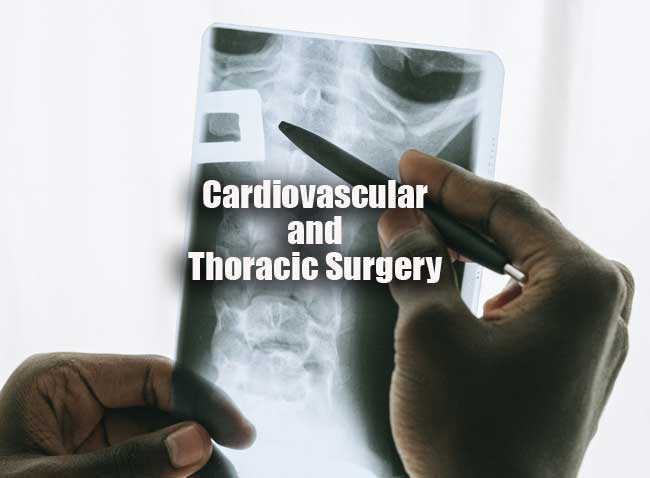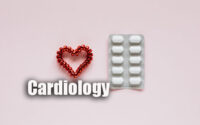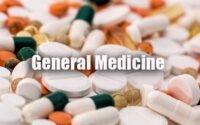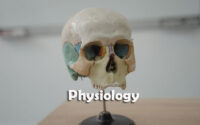Cardiovascular and Thoracic Surgery Quiz
Cardiovascular and Thoracic Surgery Quiz paper for the written examination is given below. Candidates who are looking for Cardiovascular and Thoracic Surgery exam Quiz paper can find in this section. The applied candidates who are getting prepared for the Cardiovascular and Thoracic Surgery can view this page for the Cardiovascular and Thoracic Surgery Last Ten Years Quiz Papers.

Download the Cardiovascular and Thoracic Surgery Quiz & Solutions & make it as a reference for your exam preparation. Take advantage of these Cardiovascular and Thoracic Surgery Quiz Papers in a proper manner to get qualifying Marks. Last 5 years Cardiovascular and Thoracic Surgery Quiz Papers provided here. Candidates who are applied for the above exam can check and download the Cardiovascular and Thoracic Surgery Quiz Papers from here.
Quiz on Cardiovascular and Thoracic Surgery
1. Isolated R.V. dysfunction is manifested by all except
(1) High C.V.P.
(2) Variable P.A. pressure
(3) Hypervoluemic left ventricle
(4) Low cardiac output
2. In postoperative period in ICU. hypothermia can cause all except
(1) Predispose arrhythmias.
(2) Increased S.V.R. and cause hypertension.
(3) Produce platelet dysfunction.
(4) Decrease peripheral O2 consumption and CO2 production by shivering.
3. In postoperative management, the tidal volume and respiratory rate are selected to achieve a minute ventilation of
(1) Approximate 100 ml/kg./min.
(2) Approximate 50 ml/kg./min.
(3) Approximate 80 ml/kg./min.
(4) Approximate 120 ml/kg./min.
4. One unit of platelet transfusion (R.D.P.) should increase the platelet counts by
(1) 5—7000
(2) 7- 10000
(3) 10— 15000
(4) 15 —20000
5. Inhaled nitric oxide (NO) is administered via the ventilatory circuit for pulmonary vasodilatation in the dose of
(1) upto 40 ppm
(2) 40 —60 ppm
(3) 60-80 ppm
(4) More than 80 ppm
6. Packed Red Blood Cells (P.C.V.) have an average haematocrit of
(1) 30%
(2) 50%
(3) 70%
(4) 100%
7. Failure criterias during weaning from the ventilation are all except
(1) Heart rate changes by more than 20%.
(2) Systolic B.P. rises by more than 20 mm Hg.
(3) Respiratory rate increases by more than 10 breaths/min.
(4) PCO2 falls below 40 torr.
8. Normal Cardiac index is
(1) 1.6 to 2.2 L/min/m2
(2) 2.2 to 4.0 L/min/m2.
(3) 4.0 to 5.2 L/min/m2.
(4) 5.2 to 6.5 L/min/m2.
9. What is incorrect regarding T.A.B.P. ?
(1) Aortic end-diastoliz pressure is lower.
(2) Balloon-assisted peak systolic pressure is lower.
(3) Coronary perfusion is increased by diastolic augmentation.
(4) Increased impedence to ejection during systole.
10. L.M.W.H. is monitored by
(1) P.T./INR
(2) aP.T.T.
(3) Anti-factor Xa
(4) Anti-factor IVa
11. What is the most common pathogen causing prosthetic valve endocarditis ?
(1) Staphylococci
(2) Enterococci
(3) Fungi
(4) Gram negative organisms
12. What should be target INR in Bileaflet mitral valve and aortic valve with atrial fibrillation ?
(1) 1.5-2.0
(2) 2.0—2.5
(3) 2.5-3.5
(4) 3.5-4.0
13. Which of the following does not decrease I.N.R. when given along with oral anticoagulation ?
(1) Green leafy vegetables
(2) Green tea
(3) Soyabean oil
(4) Ginger and Garlic
14. Which of the following statements regarding Postpericardiectomy syndrome is incorrect ?
(1) More common in young patients.
(2) Reported in 15-20% of patients following open heart surgery.
(3) It represent an autoimmune inflammatory response.
(4) It does occur in 1st week of surgery only.
15. These rhythm changes can be seen in follow up of cardiac patients as digoxin toxicity except
(1) A-V. block
(2) Nonparoxysmal A.V junctional tachycardia
(3) Sinus tachycarida
(4) P.V.Cs (Multiform and bigeminy )
16. Early prosthetic valve endocarditis is within __________ of surgery.
(1) 30 days
(2) 60 days
(3) 90 days
(4) 120 days
17. Following are the noncardiac side effects of the prolonged use of Amiodarone except
(1) Pulmonary toxicity
(2) Hepatic dysfunction
(3) Renal dysfunction
(4) Corneal microdeposits
18. Following are the indications of permanent pacemaker (PPI) following cardiac surgery except
(1) Complete heart block following aortic valve surgery.
(2) Advanced second-degree heart block with a slow ventricular response.
(3) Tachycardia-Bradycardia syndrome.
(4) Fast ventricular response to atrial fibrillation.
19. For pneumothorax, which of the following is the treatment of choice ?
(1) T.P.P.V.
(2) ICD with underwater seal bag.
(3) Thoracotomy and closure of the vent.
(4) Wait and watch.
20. Treatment of choice for hemothorax of blood loss of greater than 500 ml/hr for consecutively 3 hrs.
(1) Wait and watch
(2) Needle aspiration
(3) Intercostal tube drainage
(4) Open thoracotomy and ligation of bleeding point
| Practice Set | MCQs |
| Quiz | Questions and Answers |
21. Which of the following is incorrect regarding flail chest ?
(1) It is defined as fracture of > 4 ribs unilateral or bilateral.
(2) It results in paradoxical motion of local region.
(3) Ventilation with I.P.P.V. is the treatment of choice for unstable patient.
(4) Operative fixation of flail segment is not recommended.
22. Which of the following is false regarding trachea-bronchial trauma ?
(1) Penetrating injury is more common than blunt trauma.
(2) It manifests with persistent massive air leak.
(3) ‘Fallen lung sign’ is suggestive of tracheo-bronchial injury.
(4) Bronchoscopy is contraindicated.
23. Chronic lung disease is called severe when
(1) FEV1 is 60-75% of predicted value.
(2) FEV1 is 50-59% of predicted value.
(3) FEV1 is less than 50% of predicted value.
(4) FEV1 is more than 75% of predicted value.
24. The most common benign tumor of lung is
(1) Hamartoma
(2) Alveolar adenoma
(3) Teratoma
(4) Tibroma
25. Investigation of choice for pulmonary embolism is
(1) Ventilation Perfusion scan
(2) M.R.I.
(3) C.E.C.T.
(4) 2.D-echo
26. The first step during pneumonectomy for Carcinoma of lung is
(1) Ligation of Pulmonary Vein
(2) Ligation of Pulmonary Artery
(3) Divide the bronchus
(4) Lymph node clearance
27. Hoarseness of voice secondary to bronchogenic carcinoma is usually due to the extension of tumor into
(1) Vocal cords
(2) Superior laryngeal nerve
(3) Left recument laryngeal nerve
(4) Right vagus nerve
28. Pancoast tumor usually involve
(1) C2—C6 spinal nerves
(2) T2—T5 spinal nerves
(3) C7—T1 spinal nerves
(4) T5—T9 spinal nerves
29. Standard therapy for limited stage small cell carcinoma of lung is
(1) Chemotherapy
(2) Radiotherapy
(3) Surgical resection
(4) All of the above
30. Horner’s syndrome consist of
(1) Ptosis
(2) Mhiosis
(3) Anhidrosis
(4) All of the above
31. Visceral pleura is supplied by
(1) Bronchial artery
(2) Pulmonary artery
(3) Both of the above
(4) None of the above
32. Cause of exudative pleural effusion is
(1) C.H.F.
(2) Nephrotic syndrome
(3) Cirrhosis of liver
(4) Neoplastic diseases
33. Dose of urokinase for intrapleural fibrinolysis in treatment of empyema patients
(1) One lac units in 100 ml saline
(2) Five lac units in 100 ml saline
(3) Ten lac units in 100 ml saline
(4) Fifteen lac units in 100 ml saline
34. Which muscle is not used as a muscle flap closure of postpneumonectomy empyema space ?
(1) Pectoralis major
(2) Latissmus dorsi
(3) Serratus anterior
(4) Trapezius
35. Which is used for chemical pleurodhesis ?
(1) Bleomycin
(2) Tetracycline
(3) Doxycycline
(4) All of the above
36. In which of the following procedures, Chylothorax is not occur as a complication ?
(1) P.D.A. Surgery
(2) Coarctation of aorta surgery
(3) Resection of thoracic aortic aneurysm
(4) Pericardiectomy
37. Which substance is used for PLOMBAGE thoracoplasty ?
(1) Paraffin
(2) Poly ethylene fag
(3) LUCITF spheres
(4) All of the above
38. Contraindication of decortication in empyema are all except
(1) Major bronchial obstruction
(2) Pulmonary destruction
(3) Uncontrolled sepsis
(4) Fibrothorax
39. Diaphragm pacing is indicated in all except
(1) Central alveolar hypoventilation
(2) High cervical spinal cord injury
(3) End stage C.O.P.D.
(4) L.B.B.B.
40. Oesophagus passes through the diaphragm at the level of
(1) T6
(2) T8
(3) T10
(4) T12
41. Regarding Pectus excavatum, which is incorrect ?
(1) Posterior depression of the sternum at costal cartilage.
(2) More frequent in boys.
(3) Manubrium is usually at its normal position.
(4) 1st and 2nd ribs are depressed.
42. The normal average Ulnar Nerve Conduction Velocity (UNCV) value across the thoracic outlet is
(1) 55 m/second
(2) 59 m/second
(3) 72 m/second
(4) 94 m/second
43. Indications of flexible bronchoscopy are all except
(1) Difficult intubation
(2) Foreign body removal
(3) Laser ablation
(4) In a case of Haemoptysis due to coagulopathy
44. Tor lung reduction surgeries, which parameter is most important in spirometery ?
(1) FEV1
(2) F.V.C.
(3) T.L.C.
(4) FRC
45. During pericardiectomy which part of the heart is to be released first ?
(1) R.A.
(2) RV.
(3) L.A
(4) L.V.



